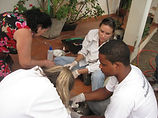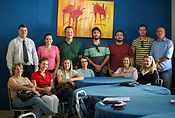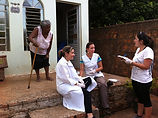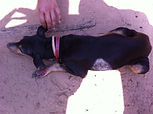Research Projects
"Caoservação"
Domestic dogs and cats in protected areas: the impacts on wild carnivores and implications for public health? Case Study Carlos Botelho State Park (PECB)
The PECB is a conservation unit (UC) in São Paulo State, which houses an important remnant of Atlantic Forest. This area has been increasingly affected by uncontrolled use of land, especially due to growth of surrounding neighborhoods, with consequent growing population of domestic animals freely passing on margins and inside the Park. The problem of cats and dogs overpopulation is shared by many currently UCs, and ends up determining an intimate contact between domestic and wild carnivores. The project aims to characterize and quantify the input stream and the usage area of dogs and domestic cats inside the PECB, identifying the impacts on wild carnivores, especially the flow of etiologic agents able to reach both populations and also the humans.
This project is funded by São Paulo Research Foundation (FAPESP), and has been performed by students and professors of the University of São Paulo with support of the National Center Predators (CENAP-ICMBio). The collaborators are: Professor Dr. Fernando Ferreira, Dr. Silvia Godoy Neri, Prof. Dr. Mark Bryan, Dr. Ronaldo Morato, Dr. Beatriz Beisiegel, and Msc. Ana Perola Brandão. Some laoratorial analisys have been done at the Laboratory of zoonosis of the São Paulo State University with collaboration of Prof. Dr. Helio Langoni.









Evaluation of effectiveness of strategies for visceral leishmaniasis prevention and control
Visceral leishmaniasis (VL) is a zoonosis transmitted by a vector. In Brazil represents a serious public and animal health problem. Although prevention and control measures have been carried out for years, the disease is continually on geographic expansion in the country, which urgents demand for the development of new tools for prevention and control. The success of effective strategies to control the VL depends on the knowledge of this strategy and the various parameters of the dynamics of infection in different populations and species that act in the epidemiological chain of the disease. Indeed, we conducted epidemiological studies related to the vectorial capacity and effectiveness of prevention and control measures, both in the field and theoretical, using mathematical modeling.
The project was funded by São Paulo Research Foundation (FAPESP) and National Council for Scientific and Technological Development (CNPq), and was conducted by students and professors of the University of São Paulo with support of Epidemiological Surveillance Department of the Municipality of Panorama-SP Health. It was developed from 2012 to 2015 with the collaboration of Prof. Dr. Fernando Ferreira, Professor. Dr. Eunice Galati, Prof. Dr. Rodrigo Soares, Dr. Fredy Galvis and Dr. Estela Lopes. In this study, diagnostic techniques and knowledge of leishmaniasis dynamic had collaboration of Dr. Javier Moreno, Dr. Eugenia Carrillo, Carmen Sanchez and other researchers from Instituto de Salud Carlos III Spain.












Welfare and populational animal sterilization in "Pontal"
Since dogs and cats were domesticated humans became responsible for providing their needs, control their population and ensure their health and well being. However, domestication and management of these animals have been inadequate in many urban and rural centers. In many cases, when these animals are improperly taken care of, and thus live wholly or partially loose without neither been vaccinated nor dewormed, they end up being able to act as reservoirs of many infectious agents. In addition, the unsterilized dogs are more aggressive than sterilized ones, making it a problem for public health. Due to fertility of dogs and cats, overcrowding remains a problem until effective programs involving control of reproduction is instructed. As a result, the excess of dogs and cats not only pose as a risk to human and environmental health, but also to these animals themselves. This scenario presents higher importance when it occurs near forest areas, compromising life of wild animals by transmitting diseases and predation.
In this project we sterilized some dogs and cats in view to contribute with a population control program of dogs and cats in Ribeirão Bonito settlement in Teodoro Sampaio city. In this region there is overpopulation of these animals and, because it is located next to Morro do Diabo State Park, presents intense contact with animals from wildlife. The wellness campaign and sterilization of dogs and cats was held in June 2011. Animals were vaccinated and wormed.
This project was coordinated by Dr. Alessandra Nava, organized by Dr. Anaia Passion Sevá, funded by Overbrook Foundation, in collaboration with Ecoehalth Aliance, Veterinary Extension Activities Center of Universidade Santo Amaro (UNISA), São Paulo, with presence of Prof. Dr. Celso Pinto Martins, Professor Dr. Mark Bryan and Professor. Dr..Adriana Cortez, and some students. We had the support of local community, Department of Health Surveillance Health, Teodoro Sampaio city, and Morro do Diabo State Park (with representation of Mr. Marcos Anavir Christofoli).





